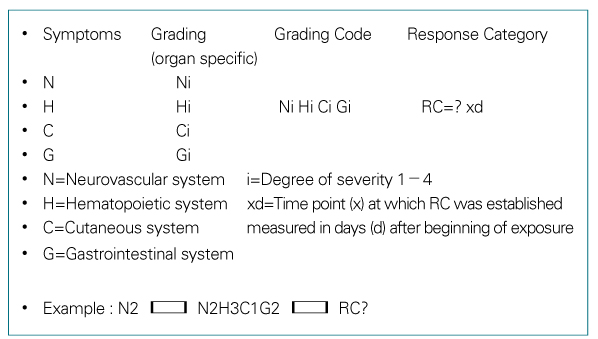J Korean Med Assoc.
2003 Oct;46(10):879-888. 10.5124/jkma.2003.46.10.879.
Diagnostic and Therapeutic Management of Acute Radiation Syndrome and Internal Contamination
- Affiliations
-
- 1Department of Nuclear Medicine, Han Il Hospital, Korea.
- KMID: 1957982
- DOI: http://doi.org/10.5124/jkma.2003.46.10.879
Abstract
- The ARS(Acute Radiation Syndrome) develops, within 60 days after exposure to ionising radiation with typical clinical signs and symptoms as a function of time. The interactions and combined effects of radiation-induced damage to different organ systems are diverse and not yet fully understood. Therefore, when accidental exposure to ionising radiation is documented or suspected, guidance for immediate diagnostic procedures and specialised care are required to handle the complexity of the ARS. The following four organ systems, Neurovascular system (N), Hematopoietic system (H), Cutaneous system (C) and Gastrointestinal system (G) are considered to be of critical significance for the development of ARS and should therefore receive special attention in the medical management of radiation accident cases. The Assessment of the severity of damage, Decision on the kind of hospitalisation, Provision of appropriate therapeutic interventions and Evaluation of the patient's prognosis must be considered in the management of a patient after a radiation accident. When significant levels of radioactive materials are incorporated, pathological consequences may ensue, making emergent treatment particularly important. However, this should not take priority over treatment of life threatening conditions and of acute injuries. Following medical stabilization, careful radiological assessment can be performed to determine the presence of both external and internal contamination. It is important to note that 1) contaminated patients do not represent a direct hazard to health care providers and 2) lifesaving procedures should not be delayed regardless of the level of contamination.
Keyword
MeSH Terms
Figure
Cited by 1 articles
-
Health Disorders Caused by Physical Factors among Health Care Workers - Focusing on Ionizing Radiation -
Hyun-Sul Lim
J Korean Med Assoc. 2010;53(6):483-491. doi: 10.5124/jkma.2010.53.6.483.
- Full Text Links
- Actions
-
Cited
- CITED
-
- Close
- Share
- Similar articles
-
- Radiological Accident and Acute Radiation Syndrome
- Analysis of Trends in Dose through Evaluation of Spatial Dose Rate and Surface Contamination in Radiation-Controlled Area and Personal Exposed Dose of Radiation Worker at the Korea Institute of Radiological and Medical Sciences (KIRAMS)
- The History of Radiation Accidents
- Contamination of an Alcyon Co-60 gamma rays by Electrons
- Annual Statistics of Radiation Therapy : 1990




